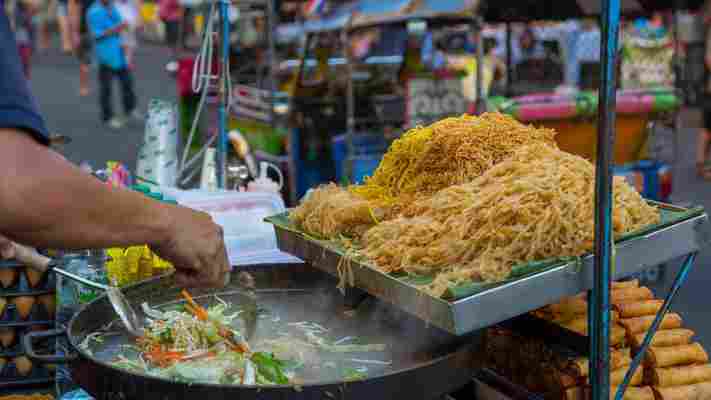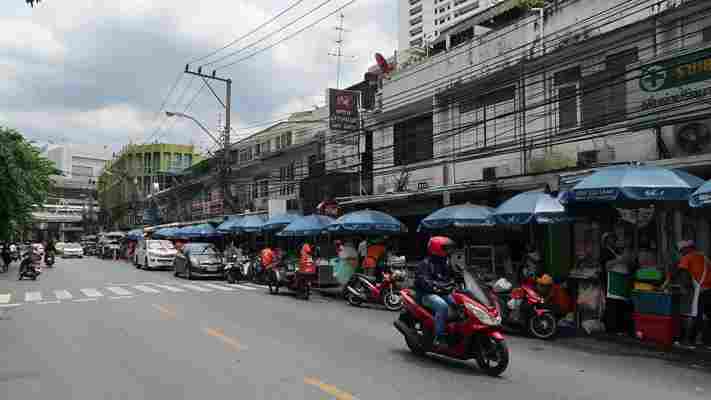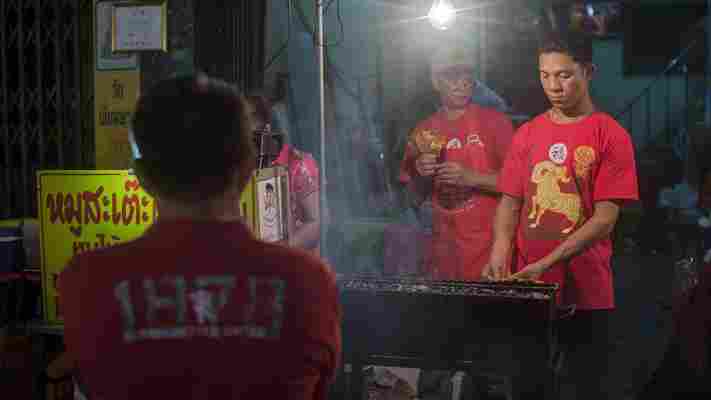Article continues below
When Thailand’s King Bhumibol Adulyadej passed away in October 2016, his subjects were plunged into mourning, wearing black for months out of respect. Now, many Thais have re-integrated colour into their wardrobes – but for the vendors of the trendy Ari neighbourhood in Bangkok’s north, the fashion choice is far more symbolic than a love of variety.
Since 2014, Thailand’s military government has made cleaning up Bangkok a major part of its political platform , targeting street vendors in an effort to reduce litter and create room for pedestrians. This initiative has garnered mixed reactions from locals, who generally agree that sanitation standards are necessary but can’t agree about how they should be implemented.
In December 2016, government officials decreed that stalls in Ari, a renowned food stall district, needed to be gone by 8 March 2017. But just days before the deadline, officials changed their minds, announcing that vendors would be allowed to stay… for now.

Street food is a crucial part of many Bangkok residents’ diets (Credit: Frank Fell/Getty Images)
You may also be interested in: • The demise of a famed food mecca • The truth about pad Thai • A city drenched in flowers
Street food is a crucial part of many locals’ diets, with food stalls offering affordable meals at a fraction of restaurant prices. At lunchtime and at the end of the workday, Ari’s pavements buzz with hungry residents waiting for their orders. A cafeteria-style stall on the corner of Phahon Yothin 7 is particularly popular for its gub kao (literally translating to ‘with rice’), a variety of meat and vegetable dishes displayed in large metal pans.
Fearing the potential loss of their livelihood, Ari’s community of street vendors rallied together, holding regular meetings to discuss ways to improve the neighbourhood and save their jobs. It was in one of these meetings that they decided to band around an ancient tradition of colour coordinating clothing to bring beauty to the pavements, and show the value they bring to Bangkok’s streets.

Street vendors in Bangkok’s Ari neighbourhood have banded together around an ancient Thai tradition (Credit: Micaela Marini Higgs)
In Thailand, each day of the week is associated with a specific colour relating to a celestial body. The tradition that stems from Hinduism, which has influenced Thai culture since the predominantly Hindu Angkor Empire ruled the region from the 9th to the 15th Century. Planets are matched to the Hindu god whose personality they best embody – for example, Surya, who is thought to have a harsh personality, came to represent the Sun. In Thailand, the gods were assigned colours based on the appearance of the planet with which they were associated. For example, Tuesday became associated with the colour pink based on the perceived colour of the planet Mars, which is linked to the Mangala, the Hindu god of war (even though Mangala is represented as red in mainstream Hindu mythology).
On Wednesdays vendors sport green, corresponding to Mercury and Hindu god Budha (not to be confused with Buddha). On Thursday, vendors wear orange, symbolising Jupiter and the god Brihaspati. On Friday, light blue represents Venus and the god Shukra. On Saturday, purple corresponds to Saturn and the god Shani. And on Sunday, red is symbolic of the sun and Surya. Monday’s colour is yellow in honour of the moon and the god Chandra. It is also the colour of the king’s flag, since both the late and current king were born on Mondays, and publicly displayed images of them often include yellow.

Sunday: Red, corresponding with the sun and the Hindu god Surya (Credit: NICOLAS ASFOURI/Getty Images)
(Credit: NICOLAS ASFOURI/Getty Images)
Monday: Yellow, corresponding with the moon and the Hindu god Chandra (Credit: Jeff Greenberg/Getty Images)
(Credit: Jeff Greenberg/Getty Images)
Tuesday: Pink, corresponding with Mars and the Hindu god Mangala (Credit: David Longstreath/Getty Images)
(Credit: David Longstreath/Getty Images)
Wednesday: Green, corresponding with Mercury and the Hindu god Budha (Credit: Danny Gagliardi/Alamy)
(Credit: Danny Gagliardi/Alamy)
Thursday: Orange, corresponding with Jupiter and the Hindu god Brihaspati (Credit: Daniel Berehulak/Getty Images)
(Credit: Daniel Berehulak/Getty Images)
Friday: Light blue, corresponding with Venus and the Hindu god Shukra (Credit: Evgeny Ermakov/Alamy)
(Credit: Evgeny Ermakov/Alamy)
Saturday: Purple, corresponding with Saturn and the Hindu god Shani (Credit: Micaela Marini Higgs)
(Credit: Micaela Marini Higgs)
Though each colour is associated with a god, the practice of wearing daily colours is so ancient that most people don’t consider it religious. Thais learn about the tradition as school children, and today the daily colours have more to do with Thai identity than religious observance. “You learn them at the same time as you learn the alphabet,” said Lek, a long-time Ari fruit vendor.
Wearing any hint of blue on Sunday could spell disaster
For centuries, different colours have been considered luckier at various points in the week – although light blue is considered lucky on Friday, wearing any hint of blue on Sunday could spell disaster. Superstitious people still take this tradition seriously, believing that not wearing the correct colour could have real-life consequences, from poor health to general bad luck. Because she was born on a Tuesday, Thai-American Darra Christensen said her family expresses constant concern that she doesn’t use a pink wallet, which they believe would help improve her finances.
"I was insanely confused at first, but then I began to realise that everyone was aware of these 'lucky' and 'unlucky' colours depending on the day of the week that they were born,” she said.
Vendors believe wearing the same colour has bolstered a sense of community (Credit: Micaela Marini Higgs)
Though it’s difficult to know exactly how effective the colour coordination has been for Ari’s street vendors, many of them believe the visual unity has helped prove to the local government that the vendors are capable of self-regulating.
It gives us a feeling of togetherness, and it helps us show it
The colours are also helping the community combat overcrowding; if people complain about an increase of rubbish and congestion on the pavement, it makes it easier for the local government to justify clearing the area. Ari’s vendors can easily spot outsiders who are trying to set up and sell in the neighbourhood by simply looking at the colour of their shirts.
For Chaiwat Kanom Pansip, who sells coin-sized fish curry puffs, everyone wearing the same colour has also bolstered a sense of community, with vendors feeling like part of the same team and not like competitors. “It gives us a feeling of togetherness, and it helps us show it,” he said.
Join over three million BBC Travel fans by liking us on Facebook , or follow us on Twitter and Instagram .
If you liked this story, sign up for the weekly bbc.com features newsletter called "If You Only Read 6 Things This Week". A handpicked selection of stories from BBC Future, Earth, Culture, Capital and Travel, delivered to your inbox every Friday.
